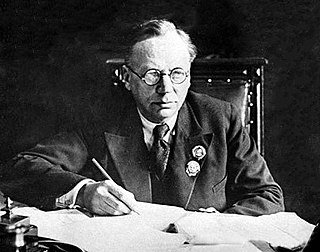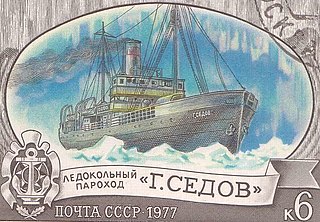
An icebreaker is a special-purpose ship or boat designed to move and navigate through ice-covered waters, and provide safe waterways for other boats and ships. Although the term usually refers to ice-breaking ships, it may also refer to smaller vessels, such as the icebreaking boats that were once used on the canals of the United Kingdom.

A nuclear-powered icebreaker is an icebreaker with an onboard nuclear power plant that produces power for the vessel's propulsion system. Although more expensive to operate, nuclear-powered icebreakers provide a number of advantages over their diesel-powered counterparts, especially along the Northern Sea Route where heavy power demand associated with icebreaking, limited refueling infrastructure along the Siberian coast, and endurance required make diesel-powered icebreaker operations challenging. As of 2023, Russia is the only country that builds and operates nuclear-powered icebreakers, having built a number of such vessels to aid shipping along the Northern Sea Route and Russian arctic outposts since the Soviet era.

Sadko was a Soviet icebreaker known for its role in scientific expeditions in the Arctic. Built as SS Lintrose in 1913 for ferry service in Newfoundland, she was sold to the government of the Russian Empire in 1915 and renamed Sadko. In Russia, she was used as a freighter in the Arctic before sinking in 1916.

Vladimir Yulyevich Wiese was a Russian scientist of German descent who devoted his life to the study of the Arctic ice pack. His name is associated with the Scientific Prediction of Ice Conditions theory. Wiese was a member of the Soviet Arctic Institute and an authority on polar oceanography. He was also the founder of the Geographico-hydrological School of Oceanography.

The Georgiy Sedov was a Soviet ice-breaker fitted with steam engines. She was originally the Newfoundland seal fishery support vessel Beothic and was renamed after Russian captain and polar explorer Georgy Yakovlevich Sedov in 1915.

Tarmo is a Finnish steam-powered icebreaker preserved in the Maritime Museum of Finland in Kotka. Built in 1907 by Sir W.G. Armstrong, Whitworth & Co Ltd in Newcastle upon Tyne, United Kingdom, she was the third state-owned icebreaker of Finland and the last Finnish steam-powered icebreaker to remain in service. When Tarmo was decommissioned in 1970, a decision was made to preserve the vessel as a museum ship. After a long wait in Helsinki, Tarmo was towed to Kotka and completely restored in the early 1990s.

Ivan Susanin class, also known by its Soviet designation Project 97P, is a series of icebreaking patrol ships built for the Soviet Navy and KGB Border Troops, and today operated by the Russian Navy and FSB Border Service.

CCGS Captain Molly Kool is a Canadian Coast Guard converted medium class icebreaker. She was originally built as an icebreaking anchor handling tug Vidar Viking for Trans Viking Icebreaking & Offshore in 2001. The vessel was acquired by the Canadian Coast Guard in August 2018 and was commissioned in May of the next year after refit.
A double acting ship is a type of icebreaking ship designed to travel forwards in open water and thin ice, but turn around and proceed astern (backwards) in heavy ice conditions. In this way, the ship can operate independently in severe ice conditions without icebreaker assistance but retain better open water performance than traditional icebreaking vessels.
Georgiy Sedov is an icebreaking platform supply vessel operated by Rosmorport in the Sea of Azov. She was built by Kværner Masa-Yards in Helsinki, Finland, in 1998 as Antarcticaborg for Wagenborg Kazakhstan to be used in the Caspian Sea.

Murmansk Shipping Company, often abbreviated as MSCO, was a Russian shipping company based in Murmansk. It was one of the primary shipping companies operating in Arctic Russia and northern Europe, in 2014 the company had 303 vessels, with a total dead weight of about 1.2 million tons. The company ran a notable museum in Murmansk.

Project 21900 icebreakers and their derivative designs are a series of Russian diesel-electric icebreakers built in the 2000s. They are also sometimes referred to using the type size series designation LK-16.

Novorossiysk is a Russian Project 21900M diesel-electric icebreaker. She was built by Vyborg Shipyard in Russia and delivered to Rosmorport in 2016.

Dobrynya Nikitich class, also known by its Soviet designation Project 97, is a diverse series of diesel–electric icebreakers and other icebreaking vessels built in the Soviet Union. In total, 32 vessels were built in various configurations for both civilian and naval service in the 1960s, 1970s and early 1980s, and several remain in service in Russia as of 2024.

Mudyug is a Russian icebreaker and the lead ship of a series of three subarctic icebreakers built at Wärtsilä Helsinki shipyard in Finland in 1982–1983. The vessel's non-rebuilt sister ships are Magadan and Dikson.
CCGS Judy LaMarsh is a Canadian Coast Guard light icebreaker. Built in 2010 as a shallow-draught icebreaking tug Mangystau-2 for the Caspian Sea oil fields, the vessel was acquired by Canada as an interim solution while the existing fleet undergoes service life extension and maintenance.
Purga may refer to one of the following icebreakers:
Georgiy Sedov was a Soviet and later Russian icebreaker and hydrographic survey vessel in service from 1967 until 1992.
This page is based on this
Wikipedia article Text is available under the
CC BY-SA 4.0 license; additional terms may apply.
Images, videos and audio are available under their respective licenses.












